Racemose, Cymose, Mixed, Special inflorescence - Types of Inflorescence Based on branching pattern and other characters | 11th Botany : Chapter 4 : Reproductive Morphology of Angiosperm
Chapter: 11th Botany : Chapter 4 : Reproductive Morphology of Angiosperm
Types of Inflorescence Based on branching pattern and other characters
![]()
![]()
![]()
![]() Based on branching pattern and other characters
Based on branching pattern and other characters
Inflorescences may also have classified based on
branching, number and arrangement of flowers, and some specialized structures.
I.
Indeterminate
(racemose)
II. Determinate (cymose)
III.
Mixed
inflorescence: Inflorescence
of some plants show a combination of indeterminate and determinate pattern
IV.
Special
inflorescence: Inflorescence
which do not confined to these patterns
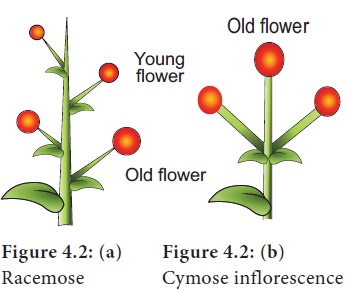
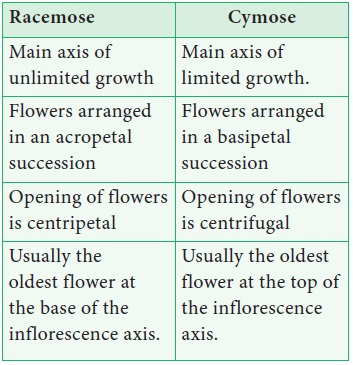
I. Racemose
![]()
![]()
![]()
The central axis of the inflorescence (peduncle)
possesses terminal bud which is capable of growing continuously and produce
lateral flowers is called racemose inflorescence. Old flowers are at the
base and younger flowers and buds
are towards the apex. It is further divided into 3 types based on growth
pattern of main axis.
1. Main axis elongated
The axis of inflorescence is elongated and contains
pedicellate or sessile flowers on it. The following types are discussed under
main axis elongated type.
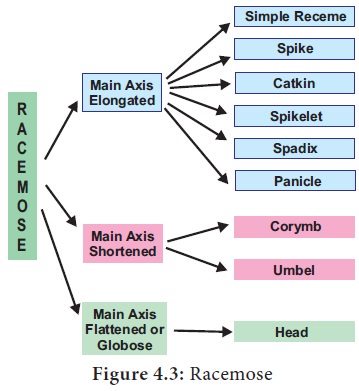
a.
Simple
raceme: The inflorescence with an
unbranched main axis bears pedicellate
flowers in acropetal succession.
Example: Crotalaria retusa, mustard
and radish.
b.
Spike: Spike is
an unbranched indeterminate inflorescence with sessile flowers. Example: Achyranthes, Stachytarpheta.
c. Spikelet: Literally it is a small spike. The Inflorescence is with branched central axis.
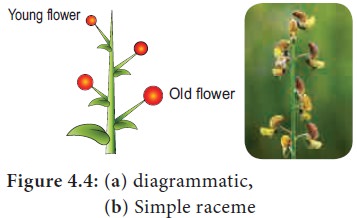
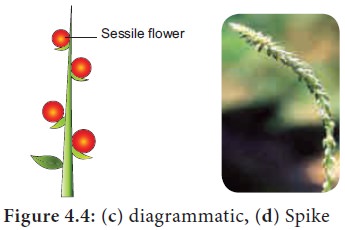
Each branch is a spikelet. Sessile flowers are formed in acropetal succession on the axis. A
pair of inflorescence bracts called glumes
is present at the base. Each sessile flower has a lemma (bract) and a palea
(bracteole). Tepals reduced to colourless scaly leaves (lodicule). Each flower
has stamen and pistil only. Example: Paddy, Wheat, Barley, Sorghum.
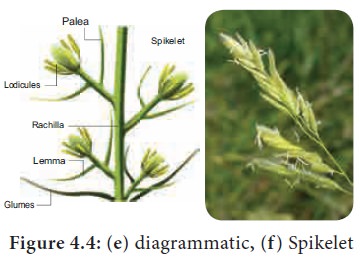
d. Catkin: Pendulous spikes with a long and drooping axis bearing small unisexual or bisexual flowers. It is also called ament. Example: Acalypha hispida, Prosopis juliflora, Piper nigrum.
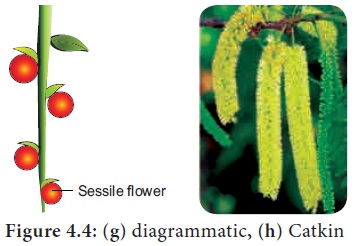
e.
Spadix: An inflorescence with a
fleshy or thickened central axis that possesses many unisexual sessile flowers
in acropetal succession. Usually female flowers are found towards the base and
male flowers are found at the apex. Entire
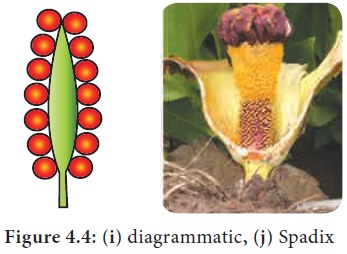
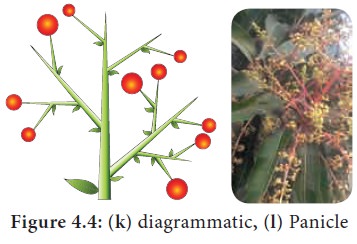
f.
Panicle: A
branched raceme is called panicle.
Example: Mangifera, neem, Delonix
regia. It is also called Compound raceme or raceme of racemes.
2. Main axis shortened:
Inflorescence with reduced growth of central axis.
There are two types namely corymb and umbel.
a.
Corymb: An inflorescence with shorter
pedicellate flowers at the top and longer pedicellate flowers at the bottom.
All flowers appear at the same level to form convex or flat topped racemose
inflorescence. Example: Caesalpinia. Compound corymb: A branched corymb is called compound corymb. Example: Cauliflower.
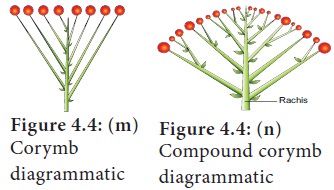
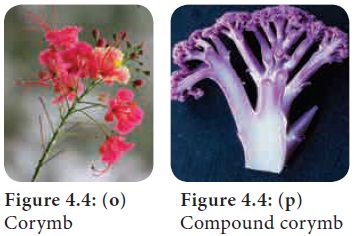
b. Umbel:
An
inflorescence with indeterminate
central axis and pedicellate flowers arise from a common point of peduncle at
the apex. Example: Allium cepa, Centella asiatica, Memecylon umbellatum. Compound umbel: It is a branched umbel. Each smaller unit is called umbellule. Example: Daucas carota, Coriandrum sativum, Memecylon
edule.
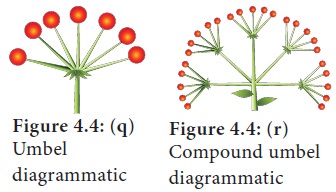
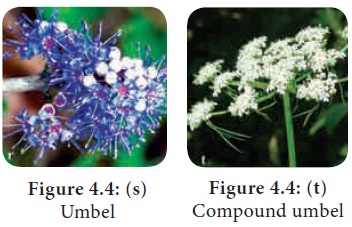
3. Main axis flattened:
The main axis of inflorescence is mostly flattened
(convex or concave) or globose. A head
or capitulum is a determinate or
indeterminate, group of sessile or sub sessile flowers arising on a receptacle,
often subtended by an involucre.
a. Head: A head is
a characteristic inflorescence of
Asteraceae and is also found in some members of Rubiaceae.
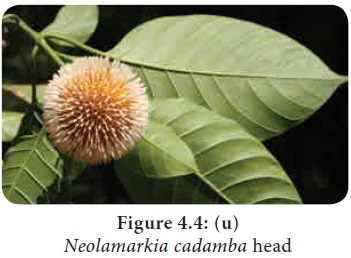
Example: Neolamarkia cadamba, Mitragyna parvifolia and in some members of Fabaceae-Mimosoideae. Example:
Acacia
nilotica, Albizia lebbeck, Mimosa pudica (sensitive plant).
Torus contains two types of florets: 1. Disc floret
or tubular floret. 2. Ray floret or ligulate floret.
The flower and inflorescence are
subtended by a lateral appendage called bract. In sunflower, you may notice
that the whorl of bracts forms a cup like structure beneath mimicking the
calyx. Such whorl of bracts is called involucre. A group of bracts present
beneath the sub unit of inflorescence is known as Involucel.
Heads are classified into two types.
i. Homogamous
head: This
type of inflorescence exhibits
single kind of florets. Inflorescence has disc florets alone. Example: Vernonia, Ageratum or Ray florets alone.
Example: Launaea, Sonchus.
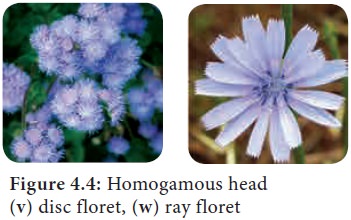
ii. Heterogamous
head: The inflorescence possesses both types of
florets. Example: Helianthus, Tridax.
Disc
florets at the centre of the head are
tubular and bisexual whereas the ray
florets found at the margin of the
head which are ligulate pistilate
(unisexual).
II. Cymose inflorescence.
![]()
![]()
![]()
Central axis stops growing and ends in a flower,
further growth is by means of axillary buds. Old flowers present at apex and
young flowers at base
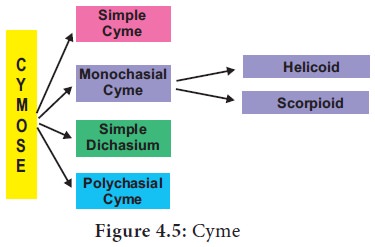
1. Simple
cyme (solitary): Determinate inflorescence consists of a single flower. It may be terminal or
axillary. Example: terminal in Trillium
grandiflorum and axillary in Hibiscus.
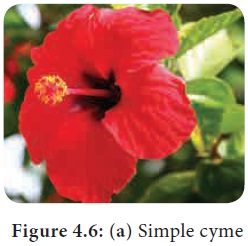
2. Monochasial
Cyme (uniparous): The main
axis ends with a flower. From two lateral bracts, only one branch grows
further. It may be helicoid (bostryx)
or Scorpioid (cincinnus).
a.
Helicoid: Axis develops on only one side and forms a coil structure atleast at the earlier development
stage. Example: Hamelia, potato.
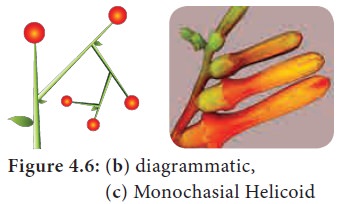
b.
Scorpioid: Axis develops on alternate sides and often becomes a coil structure. Example: Heliotropium.
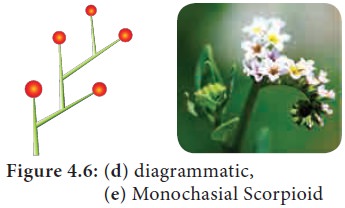
3. Simple
dichasium (Biparous): A central
axis ends in a terminal flower; further growth is produced by two lateral buds.
Each cymose unit consists of three flowers of which central one is old one.
This is true cyme. Example: Jasminum.
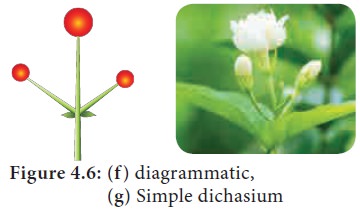
4.
Compound dichasium: It has many
flowers. A terminal old flower develops lateral simple dichasial cymes on
both sides. Each compound dichasium consists of seven flowers. Example: Clerodendron.
A small,simple dichasium is called cymule
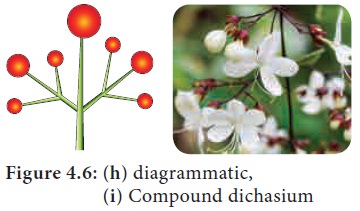
5.
Polychasial Cyme (multiparous): The central axis ends with a flower. The lateral axes branches
repeatedly. Example: Nerium

Sympdial Cyme: In monochasial cyme, successive axes
at first develop in a zigzag manner and later it develops into a straight
pseudo axis.
Example: Solanum americanum.
III. Mixed Inflorescence
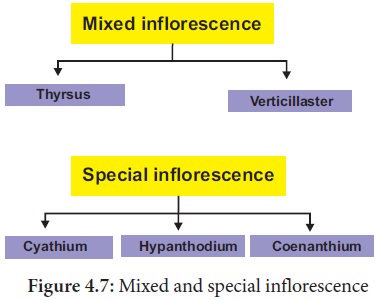
Inflorescences in which both
racemose and cymose patterns of development occur in a mixed manner. It is of
the following two types.
1. Thyrsus: It is a
‘Raceme of cymes’. Indefinite central axis bears lateral
pedicellate cymes, (simple or compound dichasia). Example: Ocimum, Anisomeles.
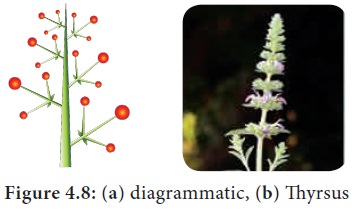
2. Verticil
or Verticillaster: Main axis bears
two opposite lateral sessile cymes at the axil of the node,each of it produces
monochasial scorpioid lateral branches so that flowers are crowded around the
node. Example: Leonotis, Leucas.
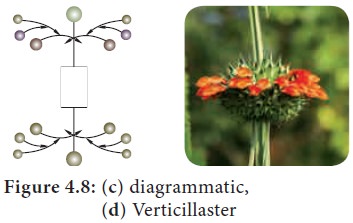
IV. Special Inflorescence
The inflorescences do not show any of the
development pattern types are classified under special type of inflorescence.
1.
Cyathium: Cyathium inflorescence consists
of small unisexual flowers enclosed by a common involucre which mimics a single
flower. Male flowers are organised in a scorpioid manner. Female flower is
solitary and centrally located on a long pedicel. Male flower is represented
only by stamens and female flower is represented only by pistil. Cyathium may
be actinomorphic (Example: Euphorbia)
or zygomorphic (Example: Pedilanthus.).
Nectar is present in involucre.
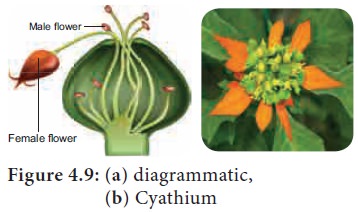
2.
Hypanthodium: Receptacle is a hollow, globose structure consisting unisexual flowers present on the
inner wall of the receptacle. Receptacle is closed except a small opening
called ostiole which is covered by a
series of bracts. Male flowers are present nearer to the ostiole, female and
neutral flowers are found in a mixed manner from middle below. Example: Ficus sp. (Banyan and Pipal).
3.
Coenanthium: Circular disc like fleshy open receptacle that bears pistillate flowers at the center and
staminate flowers at the periphery. Example: Dorstenia
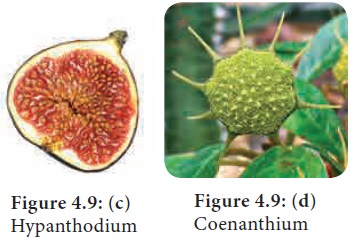
Related Topics